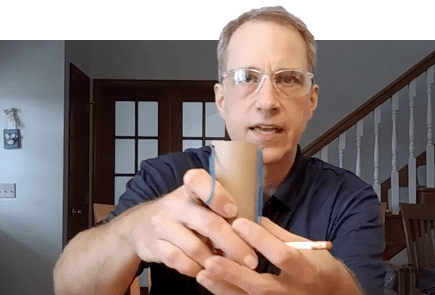Believe it or not, you can feel sound! Join Gitanjali Rao, former Discovery Education 3M Young Scientist Challenge winner of 2017, as she teaches us about the frequency of sound and how we perceive pitch.
Background
While the history of "sound science" is broad and many famous scientists have made important contributions, it is Leonardi DaVinci who is generally credited with discovering that sound actually travels in waves. However, in the 17th century, Galileo made great advancements into how we perceive sound and how sound travels. He found out about frequency of sound, and how that determines pitch. If the vibrations of a sound happen far apart, the sound will have a low frequency and sound deep. If the vibrations are close together, that will create a high-pitched sound. The way that humans perceive these vibrations is something we will explore in this experiment.
Key Concepts
- Waves
- Energy
- Sound
Materials
- An adult helper
- Balloon
- Speaker
Preparation
- Blow up the balloon so it is almost all the way full, and tie the end.
- Make a prediction: What will the balloon feel like when a loud noise happens near it?
- Hold the balloon in both hands, one hand on either side
- Hold the balloon in front of your face and say "ahhhhh" at a medium volume
- Observe what happens to the balloon. What do you feel?
- Try raising and lowering your voice in pitch (high notes and low notes) and volume (loud voice and quiet voice). What changes do you observe with how the balloon feels in your hands?
- Try playing a song or other audio using a speaker, and hold the balloon in front of the speaker. What do you notice about the way the balloon feels?
- Make sure to clean up when you are done. Pop the balloon and throw it away. Turn off your speaker system to conserve electricity.
Observation and Results
You should feel the balloon vibrate when you make noise. The intensity of the vibrations should change based on how loud the noise is, and the pitch the noise is. This happens because sound travels in waves. Sound waves are what are called longitudinal waves, which means it travels in the same direction as the disturbance that caused it. Sound is caused by something vibrating, which compresses and stretches the air around it, which vibrates your ear drum, and your brain interprets that vibration as sound. The interesting thing about this experiment is that you can feel those vibrations with your hands instead of just hearing them as sound. Think about where the vibrations from step three came from. Are those similar or different to the vibrations from step six?
Think about other situations where you have felt sound. Have you ever been able to tell a car was playing music before it even drove down your street? How do you think sound travels through different materials, like water or metal? Is there a way you could test your guesses? Are balloons the best object to feel sound through? See if you can find a different object that acts like a balloon when you make noise near it.
Safety First and Adult Supervision
- Follow the experiment’s instructions carefully.
- A responsible adult should assist with each experiment.
- While science experiments at home are exciting ways to learn about science hands-on, please note that some may require participants to take extra safety precautions and/or make a mess.
- Adults should handle or assist with potentially harmful materials or sharp objects.
- Adult should review each experiment and determine what the appropriate age is for the student’s participation in each activity before conducting any experiment.
Next Generation Science Standard (NGSS) Supported - Disciplinary Core Ideas
This experiment was selected for Science at Home because it teaches NGSS Disciplinary Core Ideas, which have broad importance within or across multiple science or engineering disciplines.
Learn more about how this experiment is based in NGSS Disciplinary Core Ideas.
Engineering Design (ETS)1: Engineering Design
Grades 3-5
- 4-PS3-2, 3. Energy can be moved from place to place by moving objects or through sound, light, or electric currents.
Grades 9-12
- HS-PS3-2, 3. At the macroscopic scale, energy manifests itself in multiple ways, such as in motion, sound, light, and thermal energy.
Grades 3-5
- 4-PS3-2, 3. Energy is present whenever there are moving objects, sound, light, or heat. When objects collide, energy can be transferred from one object to another, thereby changing their motion. In such collisions, some energy is typically also transferred to the surrounding air; as a result, the air gets heated and sound is produced.
Grades K-2
- 1-PS4-1. Sound can make matter vibrate, and vibrating matter can make sound.
Grades 3-5
- 4-PS4-1. Waves of the same type can differ in amplitude (height of the wave) and wavelength (spacing between wave peaks).
Grades 6-8
- MS-PS4-1. A simple wave has a repeating pattern with a specific wavelength, frequency, and amplitude.
- MS-PS4-2. A sound wave needs a medium through which it is transmitted.
Grades 9-12
- HS-PS4-1. The wavelength and frequency of a wave are related to one another by the speed of travel of the wave, which depends on the type of wave and the medium through which it is passing.
- HS-PS4-2. Information can be digitized.
- HS-PS4-5. In digital form, information can be stored reliably and sent over long distances as a series of wave pulses.
- HS-PS4-3. Waves can add or cancel one another as they cross, depending on their relative phase, but they emerge unaffected by each other.
Grades K-2
- 1-PS4-4. People use a variety of devices to communicate over long distances.
Grades 3-5
- 4-PS4-3. Digitized information can be transmitted over long distances without significant degradation.
Grades 6-8
- MS-PS4-3. Digitized signals (sent as wave pulses) are a more reliable way to encode and transmit information.
Grades 9-12
- HS-PS4-5. Multiple technologies base on the understanding of waves and their interaction s with matter are part of everyday experiences in the modern world and in scientific research. They are essential tools for producing, transmitting, and capturing signals and for storing and interpreting the information contained in them.
Explore Additional Science at Home Videos and Activities

Diffusion with Miss America 2020
Ever wonder why things mix (or don’t mix) differently in different temperatures of water?
Join Camille Schrier, a scientist who was crowned Miss America 2020, as she explains diffusion and how substances move though water.

Inflation Station
Follow along with 3M’s Chief Science Advocate, Jayshree Seth, as she teaches students how chemistry can help put some air where it’s most needed!

Make Your Own Cotton-Ball Launcher
What can a rubber band and a cotton ball teach you about potential and kinetic energy?
Join Michael Lewandowski to make your own cotton-ball launcher and find out!

